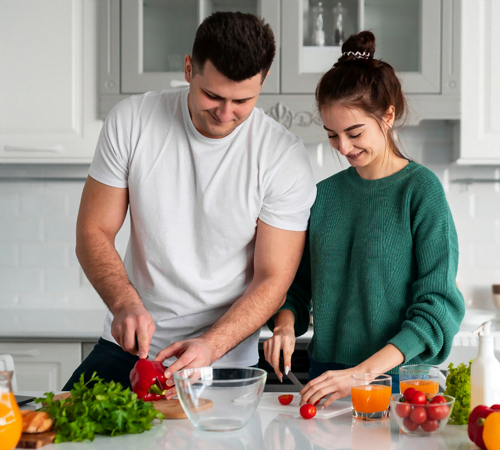
Have you ever thought about learning Spanish while you cook? We bring you this fun and very effective option. There are many ways to learn Spanish, and cooking in Spanish is one of them. Not only does it allow you to prepare delicious dishes, but it’s also a creative and entertaining way to immerse yourself in the language. Imagine being in the kitchen, following a recipe in Spanish, and at the same time expanding your vocabulary and improving your pronunciation. It’s the perfect blend of learning and flavor!
The Art of Mixing: Food and Spanish
Cooking isn’t just an everyday activity—it’s an art that becomes even more fascinating when done in another language. Cooking in Spanish gives you the opportunity to learn while you mix ingredients and follow instructions. Think about how your vocabulary expands when you hear, read, or say words like mezclar and revolver while actually doing them. It’s dynamic and flavorful learning!
The Benefits of Cooking in Spanish
Here are some advantages of cooking in Spanish that you’ll love:
- Visual and sensory memory: Associating ingredients and utensils with their Spanish names strengthens your memory effectively.
- Grammar in action: While following recipes, you practice verbs and grammatical structures as you prepare your favorite dishes.
- Guaranteed fun: Learning a new language through cooking is so entertaining that you won’t even realize how much you’re learning!

Key Words in the Kitchen
It’s proven that hands-on learning helps us retain information more easily. While cooking in Spanish, you’ll likely come across many essential culinary words that will soon become part of your daily routines. Here are some examples:
- Ingredientes (Ingredients): Basic items you need to cook, like tomate (tomato), cebolla (onion), ajo (garlic), pimienta (pepper), zanahoria (carrot), papa (potato), especias (spices), hierbas (herbs). These are essential for preparing a variety of dishes, each adding unique flavor to your recipes.
- Utensilios (Utensils): Tools that make cooking easier, like cuchara (spoon), olla (pot), sartén (pan), tenedor (fork), cuchillo (knife), batidor (whisk), colador (strainer), rallador (grater). Each has a specific purpose and is crucial for various cooking techniques.
- Acciones culinarias (Culinary Actions): Verbs describing what you do, like mezclar (to mix), revolver (to stir), freír (to fry), hornear (to bake), asar (to roast), cocer (to cook), picar (to chop), saltear (to sauté). These verbs help you describe how your dishes are prepared.
- Técnicas de cocina (Cooking Techniques): Specific methods like asar (to roast), hervir (to boil), cocinar al vapor (to steam), saltear (to sauté), freír (to fry), guisar (to stew), grillar (to grill), hornear (to bake).
- Sabor y textura (Flavor and Texture): Terms that describe the final result, like picante (spicy), suave (smooth), crujiente (crunchy), dulce (sweet), amargo (bitter), salado (salty), ácido (acidic), jugoso (juicy). These help you describe the taste and feel of your food accurately.
These words appear frequently in Spanish recipes. Learning them helps you communicate more effectively in the kitchen. See? There are many ways to learn Spanish, build your vocabulary, and enjoy the process!
The Kitchen: The Heart of the Language
The kitchen is the perfect place to learn Spanish. It’s where aromas and flavors mix with conversations and laughter, creating an ideal environment for learning. Cooking in Spanish is more than just making food—it’s a chance to immerse yourself in the culture and language authentically. And every time you use Spanish words to describe what you’re doing, you reinforce your knowledge of the language.
In many countries, Spanish-language cooking classes are available where students learn the language while preparing traditional dishes. This kind of immersion is not only educational—it’s incredibly fun. Practice your recipes in Spanish and share your experience with us! At WorldsAcross, we believe there are many ways, techniques, and tools to learn this language, and we’d love to be part of your journey.
May the Hispanic Flavor Be With You!
Cooking in Spanish transforms how you learn the language, making the process both educational and delicious. As you prepare your favorite dishes, you’ll be improving your vocabulary and understanding of Spanish. So next time you step into the kitchen, don’t forget—you’re also learning a new language!
Remember, WorldsAcross is always here to show you many fun and practical ways to connect with Spanish. So keep cooking and enjoying the process. ¡Buen provecho y mucho éxito en tu aprendizaje! (Enjoy your meal and much success in your learning!)




